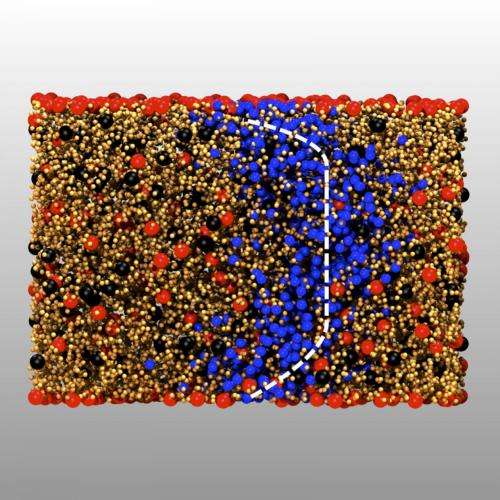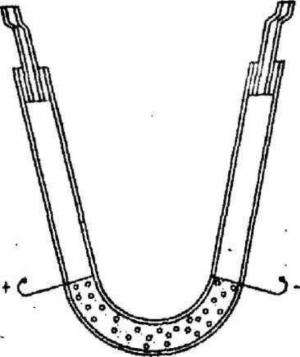Behind the dogmas of good old hydrodynamics

A new theory, which gives insights into the transport of liquid flowing along the surface under an applied electric field, was developed by a group of Russian scientists lead by Olga Vinogradova who is a professor at the M.V.Lomonosov Moscow State University and a laboratory head at the A.N. Frumkin Institute of Physical chemistry and Electrochemistry of the Russian Academy of Sciences. It may be used in the future in research in physics, chemistry and biology and has many applications in medicine and pharmaceuticals. An article describing the theory and simulations is published in Physical Review Letters.
The motion of liquid through the capillaries, porous membranes, or the thin channel under an applied electric field is called an electro-osmotic flow. This effect was discovered in 1807 by a professor of Moscow University, Ferdinand Friedrich Reuss, during a simple experiment. It involves a curved glass tube filled with water; its bend is filled with an insoluble powdered substance such as grated stone or sand, which creates a porous barrier separating both ends of the tube from each other. When a voltage is applied to the water, it begins to seep through the barrier as shown in Figure 2. The motion of dispersed particles relative to a fluid under the influence of the electric field is called electrophoresis.
Behind the apparent simplicity of the effect lies complicated physics. It was understood only a century later, in 1909, when the Polish physicist Marian Smoluchowski succeeded in describing the process of electro-osmotic flow theoretically. Nobody questioned his theory during the 20th century, and it now turns out to be only a special case of a more general theory. Moreover, it is applicable only to cases similar to Smoluchowski's, in which the liquid flows past the wettable hydrophilic surface and no-slip boundary conditions are taken into account. Now it appears that entirely different conditions are needed in cases of hydrophobic, poorly wettable surfaces.
This small "nuance" was a timely discovery, as such sciences as microfluidics and nanofluidics deal with fluid flowing through ultrathin channels. And it is difficult to drive flows mechanically in extremely thin channels, even by applying a pressure drop, which in this case should be enormously high. However, if a conventional pump is replaced by a battery, then it is possible to establish fast electro-osmotic flow in the ultrathin channel.
Sometimes physicists have to leave behind the dogmas of good old hydrodynamics. The co-authors of the article, Salim Maduar and Alexey Belyaev, have shown theoretically and confirmed in computer experiments that in quantitative description of flows in electric fields for hydrophobic surface electro-hydrodynamic slip, a boundary condition should be imposed. The new approach has immediately changed the picture.

The electro-osmotic flow is caused by the cloud of ions with the opposite sign, which forms near the charged surface of the fluid. There are two possible cases. In the first, the surface charges are immobile and able to move along the surface under the electric field applied. In the case of immobile charges, everything is relatively simple, as the speed of electro-osmotic flow increases due to hydrophobic slippage. In case surface charges can react on the applied electric field, as scientists imply, lots of different variants arise, some of which are quite unexpected. For instance, in the article, it is shown that it is possible to induce the electro-osmotic flow even near uncharged surface, or, on the contrary, to suppress such a flow completely in the channels with perfectly slipping charged walls. The lead role in the Smoluchowski theory was given to so-called zeta potential which is a physiochemical parameter calculated with a special formula and reflects the degree of electro-osmotic and electrophoretic mobility. The higher the zeta potential, the faster the flow of a liquid or particle motion. Until recently, zeta potential was considered equal to the surface potential of the solid at its boundary with the liquid. In the new theory, zeta potential also plays the leading role, but its interpretation became much more complicated.
"In the Smoluchowski theory, zeta potential is equal to the potential of the surface itself and is independent of neighbouring surfaces," Olga Vinogradova explains. "These conclusions are the result of the classical no-slip hydrodynamic conditions." Olga Vinorgradova and her colleagues have shown that in the case of hydrophobic surfaces, the hydrophobic surfaces are slippery and ions associated with the slippery surface can respond to an electric field.
So zeta potential appears to be connected with the parameters that characterize the mobility of the surface charge and hydrodynamic slippage on the surface and the dependency of the possible presence of the other surface.
The new theory makes life both more complicated and more coherent as it has immediately resolved a number of paradoxes that were considered for years. For instance, it gave an explanation to the zeta potential measurements of bubbles and drops.
"These measurements have been consistently showing that their zeta potentials are similar to those of the solid body," Olga Vinogradova says. "This was explained in particular by the presence of impurities on the surfaces of bubbles and drops. We have shown that the impurities are irrelevant and that zeta potential in this case is indeed the same as for the solid body, but due to completely different causes." The theory also helped to explain the highly debated electro-osmotic flows in foam films.
According to Olga Vinogradova, the possible practical implementations of the new theory are quite extensive; the concept of zeta potential is widely used in many fields of science and technology, such as medicine, pharmaceuticals, mineral processing, water treatment, removal of pollution from soil and more.
New interpretation of the parameter will lead to better understanding of the results of its experimental measurements and will also enable controlling its value. A particularly promising application of the new theory lies in the field of microfluidics and nanofluidics. It could be used for the creation of Lab-on-a-Chip (LOC) devices and nanofluidic diodes, which are already used for the detection and the separation of biomolecules and for the energy harvesting.
"Without no doubt, the path from the new theory to practical applications is always very long," Olga Vinogradova says, "And I suppose the experimentalists would be the first ones to use our results."
Journal information: Physical Review Letters
Provided by Lomonosov Science Project













.jpg)






